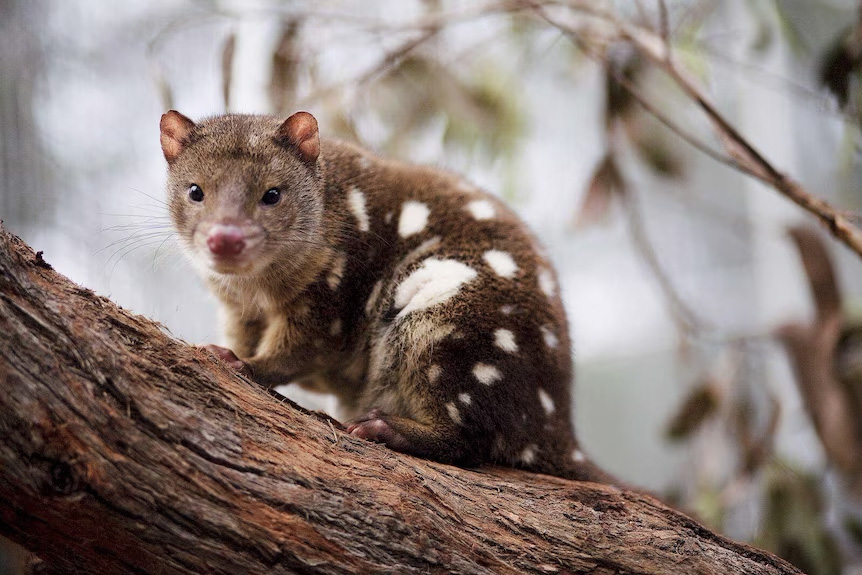Critter Corner – Spotted‐tailed quoll
#CritterCorner – Meet the Spotted-tailed quoll – A Rare Marvel of the Daintree Rainforest.
Deep in the rainforests of Queensland roams an elusive predator: the northern spotted-tailed quoll, known as “waykal” or “jungarr” by the Eastern Yalanji people. This remarkable marsupial, scientifically called Dasyurus maculatus gracilis, may look small and cute with its bright eyes, reddish-brown fur, and white spots, but it’s actually a rare and resourceful carnivore – and one of Australia’s living treasures! And as its population edges closer to extinction, protecting the northern subspecies of the spotted-tailed quoll has never been more urgent.
What makes the spotted-tailed quoll so special?
Spotted-tailed quolls are Australia’s largest native marsupial carnivores on the mainland and only second in size to the Tasmanian Devil throughout the nation. A mature northern spotted-tailed quoll can be as big as a domestic cat, weighing up to 7 kg and growing nearly 76 cm long. With a strong, elongated body and powerful jaws, these quolls are agile hunters. Their beautiful coat, a reddish-brown pelage covered in white spots (even on the tail), is a distinctive trait of the species and helps camouflage them in the dappled rainforest light.
Though not strictly tree-dwellers, these quolls are skilled climbers who use ridged foot pads for extra grip, giving them the agility to leap between branches in search of prey. The spotted-tailed quoll has the second-most powerful bite of any mammal its size, which it uses to catch everything from possums and gliders to birds and even small wallabies.
These animals are “opportunistic predators,” meaning they’ll eat nearly anything animal-based they come across, including carrion (dead animals). Despite their appetite, quolls don’t finish all their food in one sitting, returning to their catch for several days if it’s a larger meal. Their unique hunting habits and diet make them an apex predator, critical to the rainforest ecosystem, helping to keep the environment balanced and healthy.
An urgent need for habitat conservation
Recently, researchers sounded the alarm: with numbers down to fewer than 250 individuals, northern spotted-tailed quolls may be even more at risk than previously thought. This finding could lead to their reclassification as “critically endangered,” emphasising the need for rainforest protection and regeneration projects to safeguard this unique marsupial.
The northern spotted-tailed quoll faces many challenges that make it vulnerable to extinction. First, quolls have a short lifespan, living only three to four years. Females stop breeding after three, so if new quolls aren’t born or joining their population for even a couple of years, their numbers quickly drop.
Their habitat is also shrinking. Quolls need large, uninterrupted areas to roam and hunt, but habitat loss and fragmentation – breaking up large forests into small patches – make it harder for them to survive. This is worsened by fires, logging, and new roads that limit their safe space, while invasive predators like foxes and cats increase competition for food, as well as posing direct threats to their young.
Human activity also poses risks: quolls face dangers from car collisions, poison bait, and the toxic Cane Toad. Finally, climate change affects the small pockets of suitable habitats left, making it even harder for the quolls to thrive. These pressures combined make the quoll’s future uncertain and highlight why conservation is so urgent.
How can we help?
With so few of the northern subspecies of quolls left, their future is uncertain. However, efforts including replanting native trees, protecting large habitats from fragmentation, and monitoring quoll populations can make a difference. By supporting rainforest restoration projects, just like Rainforest Rescue, we can help protect their homes and give them a fighting chance.
Fun facts about the spotted-tailed quoll
- Relatives of the Tasmanian Tiger: The spotted-tailed quoll is one of the closest surviving relatives to the extinct Tasmanian Tiger.
- Tree Skills: Although they mostly roam the ground, quolls can leap between trees when hunting for prey.
- Short Lifespan: They live only about three to four years, and females usually breed just twice in their lifetimes.
- From Pouch to Den: Baby quolls start out snug in their mother’s pouch, but once they get too big, she moves them to a cosy “nursery den” while she goes out to hunt. After about 100 days, these young quolls are ready to venture out on their own.
- Mighty Bite: With the second-most powerful bite among mammals their size, quolls can take down prey much bigger than themselves.
- Small Creature, Big Impact: The spotted-tailed quoll is the largest marsupial carnivore on mainland Australia, and as an apex predator, it plays a crucial role in regulating the populations of its prey.
References
- Bubu, N, Jalun, N & Plan, N 2016, Eastern Kuku Yalanji Indigenous Protected Area Management Plan Stage 3 -Yalanjiwarra Land and Sea Country.
- Department of Climate Change, Energy, the Environment and Water, Species Profile and Threat Database: Dasyurus maculatus gracilis – Spotted-tailed Quoll (North Queensland)
- McKay, C 2023, New study reveals critically low numbers of north Queensland quolls
- Mossman Gorge Cultural Centre, Flora and Fauna
- Rowland, J, Hoskin, CJ & Burnett, S 2023, ‘Camera‐trapping density estimates suggest critically low population sizes for the Wet Tropics subspecies of the spotted‐tailed quoll (Dasyurus maculatus gracilis)’, Austral Ecology, vol. 48, no. 2.
- Wildlife Preservation Society of Queensland, Spotted-tailed Quoll
This article was written for Rainforest Rescue by Sian Bostrom – for more of Sian’s work, visit http://www.sianbostrom.com/
Want more good Rainforest news in your life?
Subscribe to our eNews | Follow us on Instagram | Like us on Facebook | Subscribe to our YouTube channel
Help Protect Rainforests Forever
Donate to Protect Rainforests Forever | Become a Rainforest Guardian | Partnership Options


